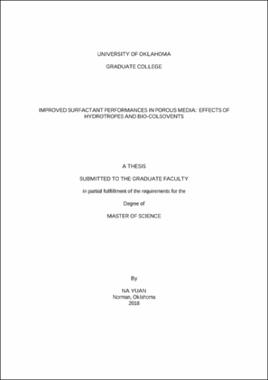| dc.contributor.advisor | Shiau, Benjamin | |
| dc.contributor.author | Yuan, Na | |
| dc.date.accessioned | 2018-12-11T15:52:28Z | |
| dc.date.available | 2018-12-11T15:52:28Z | |
| dc.date.issued | 2018-12 | |
| dc.identifier.uri | https://hdl.handle.net/11244/316311 | |
| dc.description.abstract | Surfactant flooding for the mobilization of residual oil is a promising technology for enhanced oil recovery (EOR) and surfactant enhanced aquifer remediation (SEAR). A significant economic barrier to the widespread use of the technology is the loss of surfactant through adsorption on aquifer and reservoir minerals. Especially in the case of EOR in highly saline brines, adsorptive losses of surfactant may be the single essential expense in the application. In this study, we examine the use of hydrotropes to reduce surfactant adsorption and to improve the surfactant flooding performance. The HLD equation, interfacial tension measurement and phase behavior of salinity scan were used to determine the Winsor type III microemulsion on four types of pure alkane hydrocarbons. Linear mixing rule has also is utilizing during the analysis. A new method has been established for the detection of hydrotropes, which is using the UV-VIS spectrophotometer on a targeted wavelength range. Adsorption amount is measured and compared within three types of sand materials. | en_US |
| dc.subject | Hydrotrope | en_US |
| dc.subject | surfactant flooding | en_US |
| dc.subject | enhanced oil recovery | en_US |
| dc.subject | Surfactant adsoprtion | en_US |
| dc.title | IMPROVED SURFACTANT PERFORMANCES IN POROUS MEDIA: EFFECTS OF HYDROTROPES AND BIO-COLSOVENTS | en_US |
| dc.contributor.committeeMember | Harwell, Jeffery | |
| dc.contributor.committeeMember | Xingru, Wu | |
| dc.date.manuscript | 2018-12 | |
| dc.thesis.degree | Master of Science | en_US |
| ou.group | Mewbourne College of Earth and Energy::Mewbourne School of Petroleum and Geological Engineering | en_US |
